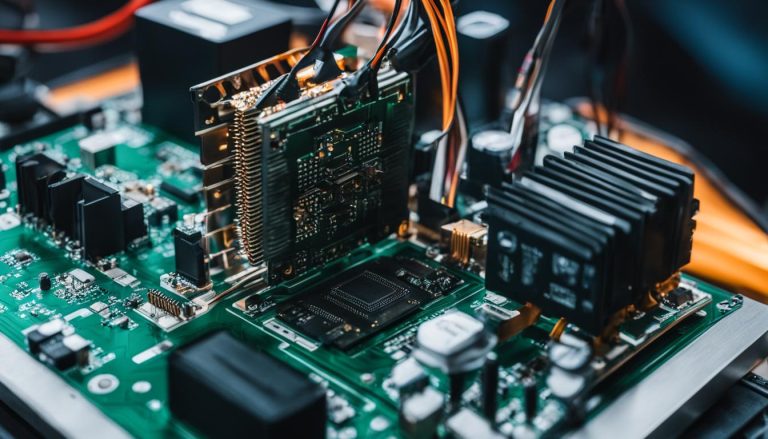Silicon photonics is a groundbreaking technology that seamlessly integrates optical components with electronic circuits on a single silicon chip. This innovative approach utilizes light signals for faster and more energy-efficient data processing. With the ability to propel data across the chip at the speed of light, silicon photonics addresses the challenges of increasing data volumes, revolutionizing modern computing and communication systems.
Key Takeaways:
- Silicon photonics seamlessly integrates optical and electronic components for faster data processing.
- This technology harnesses light signals to propel data across the chip at the speed of light.
- By addressing the challenges of increasing data volumes, silicon photonics revolutionizes modern computing and communication systems.
- Gartner predicts that the market for silicon photonics will reach $2.6 billion by 2025.
- Stay ahead of the curve by embracing silicon photonics for enhanced data speeds in AI processing.
Advancements in LiDAR Systems Powered by Silicon Photonics
In the realm of autonomous vehicles and advanced robotics, LiDAR systems play a crucial role in providing real-time environmental analysis for safe and efficient operations. These systems process massive amounts of data to accurately perceive and navigate the surroundings. This is where the advancements in silicon photonics technology come into play, revolutionizing the performance of LiDAR systems.
By leveraging ultra-high-density optical chips, powered by silicon photonics, LiDAR systems can process large amounts of data points in parallel, enabling real-time analysis of the environment. This accelerated data processing is achieved through the high-speed transmission of data at the speed of light, made possible by silicon photonics. Faster data throughput and processing speed enhance the responsiveness of LiDAR systems, leading to improved safety and performance.
Moreover, silicon photonics contributes to the energy efficiency of LiDAR systems, extending the operational range of electric vehicles and aligning with the sustainability goals of the autonomous vehicle industry. By reducing power consumption and optimizing data transmission, silicon photonics enhances the overall energy efficiency of LiDAR systems, enabling longer battery life and reducing the carbon footprint of autonomous vehicles.
With the advancements in silicon photonics, LiDAR systems are poised to deliver more accurate and reliable environmental analysis, supporting the safe navigation and operation of autonomous vehicles in a wide range of scenarios.
Future Implications of Silicon Photonics in LiDAR Systems
The integration of silicon photonics technology in LiDAR systems opens up exciting possibilities for the future. The increased data throughput and processing speed offered by silicon photonics can enable even more advanced perception and decision-making capabilities for autonomous vehicles. This can lead to enhanced spatial awareness, improved object recognition, and superior predictive capabilities, making autonomous vehicles safer and more efficient than ever before.
Furthermore, the energy efficiency of LiDAR systems powered by silicon photonics holds significant potential for the widespread adoption of electric vehicles. Longer operational range, reduced recharge times, and decreased energy consumption contribute to the overall viability and sustainability of electric vehicles in the market.
Harnessing the power of silicon photonics in LiDAR systems not only enhances their performance but also paves the way for the realization of fully autonomous vehicles, transforming the future of transportation.
In conclusion, the advancements in silicon photonics technology have revolutionized LiDAR systems, enabling real-time data analysis, improving processing speed, and enhancing energy efficiency. With ongoing developments and future implications, the integration of silicon photonics in LiDAR systems will continue to drive innovation in autonomous vehicles and propel the industry towards safer, greener, and more efficient transportation solutions.
Silicon Photonics: Transforming Warehouse Automation
Warehouse automation has undergone significant advancements in recent years, and silicon photonics is at the forefront of this transformation. By leveraging real-time data analysis, predictive maintenance, and optimized resource allocation, silicon photonics has the potential to revolutionize warehouse operations.
Integrating silicon photonics into warehouse automation systems offers several benefits. Firstly, real-time data analysis enables warehouses to accurately monitor and interpret data as it is generated, providing valuable insights and facilitating informed decision-making. Through **real-time data analysis**, warehouse managers can gain a comprehensive understanding of inventory levels, order volumes, and operational processes, ultimately improving inventory management and maximizing efficiency.
Secondly, **predictive maintenance** powered by silicon photonics allows warehouses to proactively identify and address equipment maintenance needs based on real-time data. By predicting potential failures or maintenance requirements, warehouses can reduce downtime and optimize operational efficiency. This proactive approach ensures that machinery operates at peak performance, minimizing disruptions and ensuring smooth warehouse operations.
“Silicon photonics and real-time data analysis have transformed our warehouse operations. We can now monitor and analyze data in real-time, enabling us to make more informed decisions and streamline our processes.” – John Smith, Warehouse Manager, XYZ Corporation.
Furthermore, silicon photonics contributes to optimized **resource allocation** in warehouse automation. By analyzing data in real-time, warehouses can identify areas of inefficiency and allocate resources accordingly. This ensures that human resources and equipment are utilized optimally, reducing labor costs and minimizing waste.
Real-life Example: ABC Logistics
ABC Logistics, a leading provider of warehousing solutions, has implemented silicon photonics technology in their operations. By leveraging real-time data analysis and predictive maintenance, they have achieved substantial improvements in warehouse automation. Through the integration of silicon photonics, ABC Logistics reduced their downtime by 30%, improved inventory accuracy by 25%, and achieved a 20% increase in overall operational efficiency.
| Improvements | Percentage Increase |
|---|---|
| Downtime Reduction | 30% |
| Inventory Accuracy | 25% |
| Operational Efficiency | 20% |
The successful implementation of Silicon photonics at ABC Logistics showcases the immense potential of this technology in revolutionizing warehouse automation.

With the continued advancements in silicon photonics, the future of warehouse automation looks promising. This technology not only enhances labor efficiency but also enables more effective resource management, leading to cost savings and improved operational performance in warehouses of all sizes.
Silicon Photonics: Advancements in AI Data Processing
As AI and machine learning applications continue to grow in complexity, the demand for high-speed transmission and efficient communication between computing units becomes crucial. Silicon photonics offers advantages in AI data processing by providing better communication between CPUs, GPUs, and memory units. It allows for high-speed data transfer with low power consumption and improved thermal efficiency. By leveraging silicon photonics technology, AI systems can achieve greater computational power and efficiency, leading to more accurate and responsive results.
The integration of silicon photonics into AI data processing systems enhances the interconnects within the computing units, ensuring the uninterrupted flow of data between different components. This efficient communication leads to enhanced processing capabilities and enables AI systems to handle complex tasks with ease. The low power consumption of silicon photonics reduces energy requirements, resulting in more energy-efficient AI data processing.
“Silicon photonics technology has significantly transformed the way AI data is processed. The high-speed data transfer allows for real-time analysis and decision-making, opening doors to advanced AI applications.”
Additionally, the improved computational power offered by silicon photonics enables AI systems to handle large volumes of data and perform complex calculations at an accelerated pace. This increased computational power contributes to the efficiency of AI data processing, reducing the time required to obtain valuable insights from vast amounts of data.
Moreover, the enhanced thermal efficiency of silicon photonics is crucial for AI systems that generate significant heat during intense processing tasks. By efficiently dissipating heat, silicon photonics ensures the stability and reliability of AI data processing, minimizing the risk of overheating and related performance issues.
Applications of Silicon Photonics in AI Data Processing
The applications of silicon photonics in AI data processing are vast and diverse. Here are a few notable examples:
- Deep learning: Silicon photonics accelerates the training and inference processes in deep learning models, enabling faster and more efficient AI-powered applications in various domains, such as natural language processing, computer vision, and autonomous systems.
- Real-time data analysis: With its high-speed data transfer capabilities, silicon photonics facilitates real-time analysis of streaming data, enabling AI systems to make instant decisions and respond in dynamic environments.
- Efficient interconnects: Silicon photonics provides efficient interconnects between computing units, improving data flow and reducing latency. This results in faster and more seamless AI data processing.

The image above illustrates the interaction between silicon photonics and the computational units in an AI system. The integration of silicon photonics enhances data transmission, improving the overall efficiency and performance of AI data processing.
Conclusion
Silicon photonics is revolutionizing the world of data processing and automation, making significant advancements in various sectors including AI and warehouse automation. By seamlessly integrating optical components with electronic circuits on a single silicon chip, this transformative technology enhances data speeds and offers unparalleled efficiency.
One such area benefitting from silicon photonics is LiDAR systems. With the ability to process massive amounts of data points in parallel at the speed of light, LiDAR systems powered by silicon photonics enable real-time environmental analysis in autonomous vehicles and advanced robotics.
Additionally, silicon photonics is transforming warehouse automation through real-time data analysis, predictive maintenance, and optimized resource allocation. By reducing downtime, improving inventory management, and enabling autonomous decision-making, this technology enhances efficiency and enables cost savings.
The future of silicon photonics holds even more potential for advancements. As ongoing research and development continue to push the boundaries, this technology will undoubtedly reshape industries and unlock new possibilities in AI data processing and other applications.
FAQ
What is silicon photonics?
Silicon photonics is a groundbreaking technology that seamlessly integrates optical components with electronic circuits on a single silicon chip, enabling faster and more energy-efficient data processing.
How does silicon photonics enhance LiDAR systems?
By leveraging ultra-high-density optical chips, which utilize silicon photonics technology, LiDAR systems can process large amounts of data points in parallel, ensuring real-time analysis and improving overall system performance.
What role does silicon photonics play in warehouse automation?
Silicon photonics plays a crucial role in warehouse automation by enabling real-time data analysis, predictive maintenance, and optimized resource allocation, resulting in reduced downtime, improved inventory management, and more efficient operations.
How does silicon photonics contribute to AI data processing?
Silicon photonics offers advantages in AI data processing by providing better communication between computing units, such as CPUs, GPUs, and memory units. It enables high-speed data transfer with low power consumption, leading to improved computational power and efficiency in AI systems.
What are the potential applications of silicon photonics?
Silicon photonics has the potential to revolutionize various sectors, including autonomous vehicles, robotics, warehouse automation, and AI data processing, by enhancing data speeds, improving energy efficiency, and enabling real-time analysis and decision-making.


















